Celebrating the collaborations that transform materials from soil to skin, we set out to visit each designer creating a full look for the Climate Beneficial Fashion Gala. Here we share excerpts from three conversations: read on for inspiration from their design practices and pathways to sustainability, and how each consumer, designer, and the fashion industry as a whole can take part in environmental restoration. Join us for the Climate Beneficial Fashion Gala on September 23rd to see creations by these designers and more.
Written by Erin Walkenshaw and photographed by Paige Green.
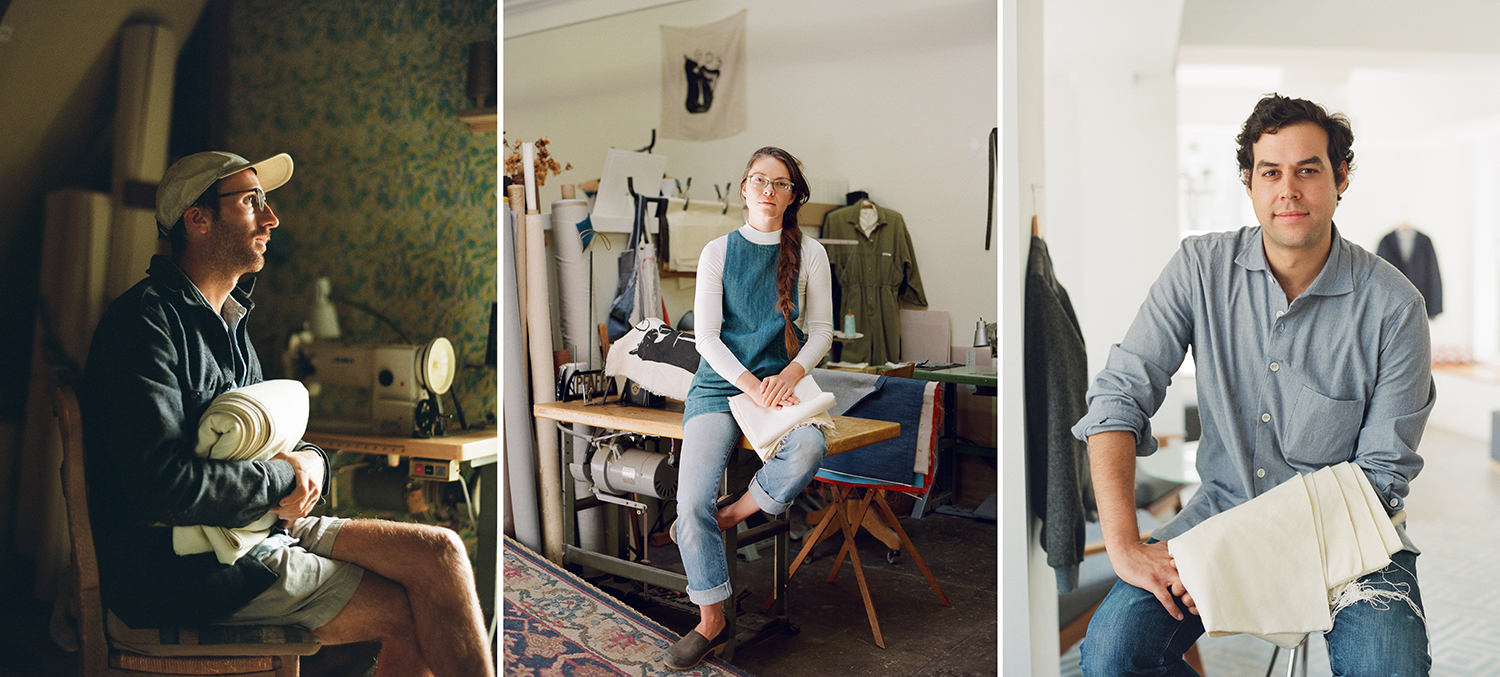
Victor Kali, pictured above right, the creator of Kali Made Garments, welcomes us into his workspace in a triangular art-deco building, where he is getting back to his roots in the art of dressing well. After shifting between business and design at Banana Republic, Kali opened his line in the heart of downtown Oakland, where his quick talking, constant moving energy matches the bustle of the city around us as he explains his excitement to be a part of reinvigorating regional textile manufacturing.
We find Geana Sieburger, pictured above center, the owner and and creative force behind GDS Cloth Goods, in a large industrial building in Oakland that she shares with a handful of other designers. Sieburger started GDS about five years ago, sewing on weekends and selling her designs at the farmers markets while also working full time at Britex Fabrics. GDS is now Sieburger’s full time gig and has evolved into a line of “responsibly produced staple pieces for wear and use” including aprons, Ebb reusable cloth coffee filters, and education on extending the life of clothing.
We follow Matt Katsaros, pictured above left, down a narrow, curving stairway to his studio space in the outer sunset neighborhood of San Francisco. Here he designs, cuts, sews, and dyes the bags, quilts, aprons, cushions, and other items that he sells under his Flint Outdoors label. As the afternoon sun wanes, Katsaros chats about his work to elevate each step in his manufacturing process to a thing of beauty — and his affection for elbow patches.
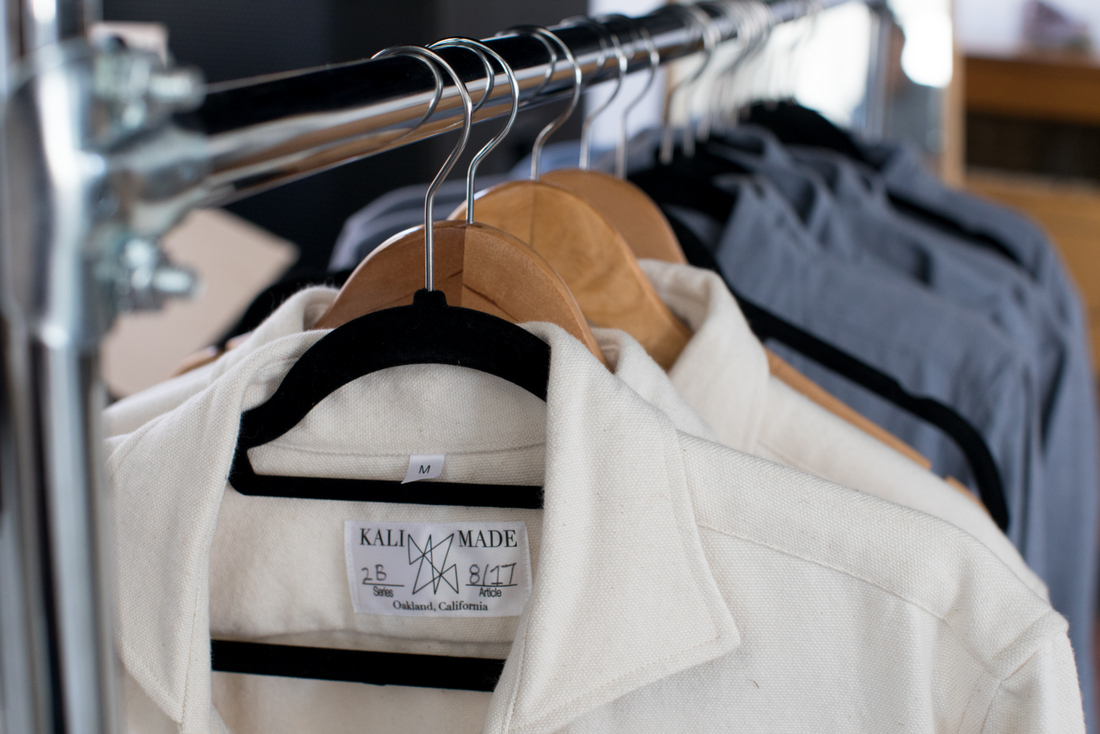
Becoming a Material Goods Producer: Is there a moment that stands out as a step toward sustainability in your path as a designer?
Kali Made: “Back in 2012 I went on a cotton tour. We went to all these farms that were producing cotton, watched it being ginned, and that was when the ball started rolling in my mind. It got me thinking about why are we sourcing cotton from so far away, and what’s that process of taking that cotton from the soil to a shirt, from there I just went down the rabbit hole of sustainable textile manufacturing which resulted in me starting Kali Made. Then, more recently, when Huston Textiles came on line, I felt like there was a local fabric available that was of the quality and in line with the vision I have for my line. Getting more into the natural dyes is my next step.”
GDS Cloth Goods: “While at California College of the Arts here in the bay area, I got obsessed with the meaning and history of the word mundane. Today it has a negative connotation of drudgery whereas the roots of the word are ‘of the earth.’ So it’s this work of the earth that we, our civilization, are trying to do less of. And how that relates to the progress of our civilization- getting further and further away from the work of the earth. This brought a lot of utilitarian ideas to my work and as a part of that process I created a Shaker inspired uniform that I wore for three months while in college. Which felt like it was the first time I accessed the potential of fashion to portray a bigger message, that the clothing had a purpose beyond providing shelter.”
Flint Outdoors: “I want to be connected to the thing that I am making from start to finish. I feel there is value in things being made in a beautiful way, through the whole manufacturing process. I was thinking about the manufacturing process of other products and that led me to reflect on the material goods I was using in my bags. I started asking my suppliers questions about the textiles and realized that there was a lack of traceability, that they usually could not answer where the cotton was grown, let alone how it was grown. That lack of traceability drove me to do more research, to start finding sources for fabrics that were more in line with my values.”
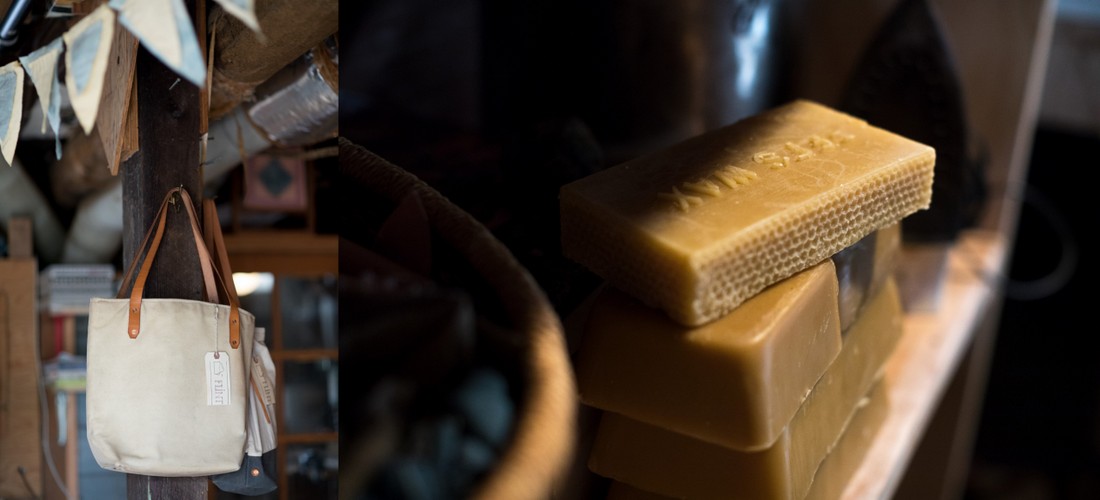 Elements of Matt Katsaros’ material and manufacturing processes in the Flint Outdoors studio.
Elements of Matt Katsaros’ material and manufacturing processes in the Flint Outdoors studio.
Landscapes of Influence: Is there a landscape that you identify with, and one that informs your designs?
Kali Made: “The city of Oakland and the people that are walking down the street outside and working in the many creative outlets around the city. I see my line as pieces they can wear from work to dinner as they move around this community. To keep that local influence strong, I’d like to do more collaborations on one-off projects with local boutiques or other designers, all these local artists that are around here. Producing locally and small allows you to experiment, adapt, and be nimble when opportunities come up.”
GDS Cloth Goods: “The very inner, intimate world. I’m actually kind of a home-body. The way the light comes in, the way the wind comes through a window. The inspiration for my designs is that sharing of my intimate inner world, an offering. I make these things for other people, but they always start in my home.”
Flint Outdoors: “Well, I’m from Los Altos and I grew up in the rolling hills around there. I definitely love the beach too… I made [my designs] with the purpose of fitting into my life which often involves going outside. So I needed materials that can withstand being tossed around, getting dirty, and a long hike back.”
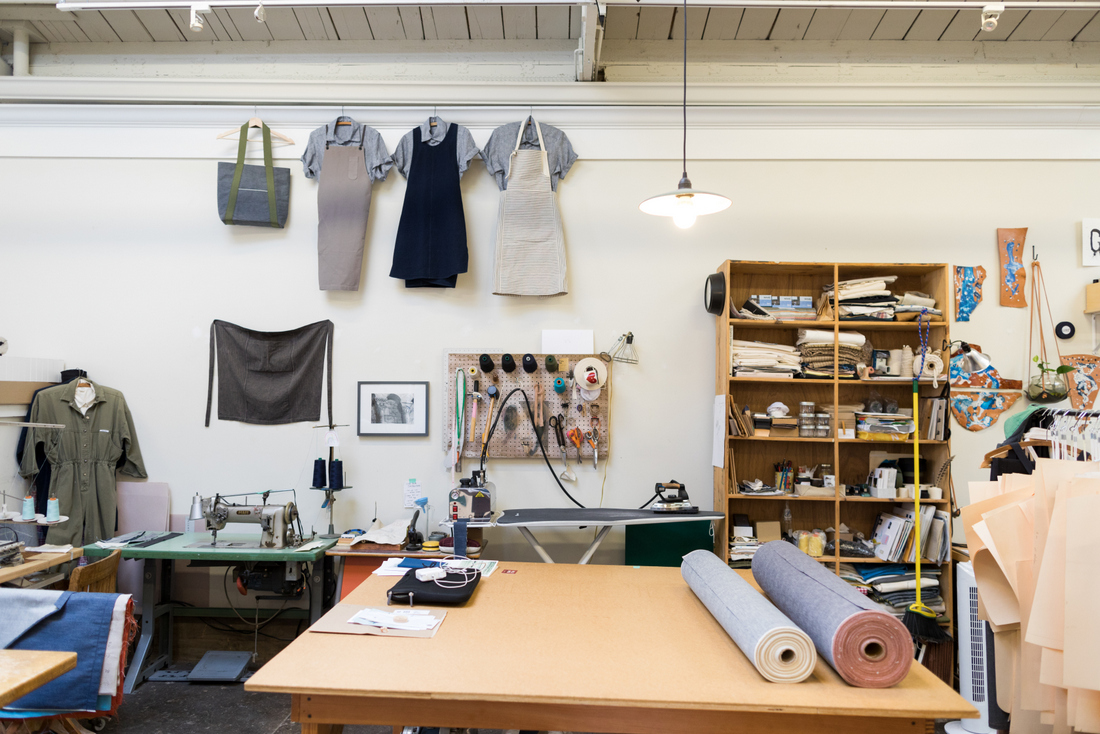
Inside the GDS Cloth Goods workshop.
Design and Fashion as Participants in Environmental Restoration: What role do you think design and fashion can play in ecosystem restoration and strengthening the climate justice movement?
Kali Made: “This was one of the things that was so interesting about the recent Huston [Textiles] opening celebration. Hearing about the farmer and social justice part of it really tied things together, especially when you realize what a massive industry fashion is and therefore the potential for impact is huge. I spent so long working in the seasonal fashion trends where you go from florals to plaids, etc. My philosophy going forward is shifting the whole notion of the industry from trend driven to pieces that will look good and last for 30 years.”
GDS Cloth Goods: “Good thoughtful design can be inspiring. Design can bring attention to details and bring up conversations that can be had more easily when they’re about objects people are instinctively or emotionally drawn to. People make time to listen when they’re into it. I think design and fashion are more approachable ways of connecting with people about Climate Justice rather than through a discussion on politics, for instance. Even if not directly, maybe design and fashion open paths to seeing how we perpetuate issues contributing to the climate crisis… If you give people something to love, they are invited to participate. They become more involved and there’s more transparency. There’s an invitation to be a part of a beautiful functional item.”
Flint Outdoors: “The curbing and hopefully destruction of fast fashion seems like the lowest hanging fruit for the design and fashion industry to contribute towards [mitigating] climate change. We need to focus on the quality and life of garments, which sometimes means long lasting and compostable materials but sometimes it also means designing pieces that won’t look stale in two years. We need to model brands like Patagonia going around fixing their garments, and people like Sierra Reading who are showing up at local farmer’s markets offering garment repair. I want to see more elbow patches, people!”
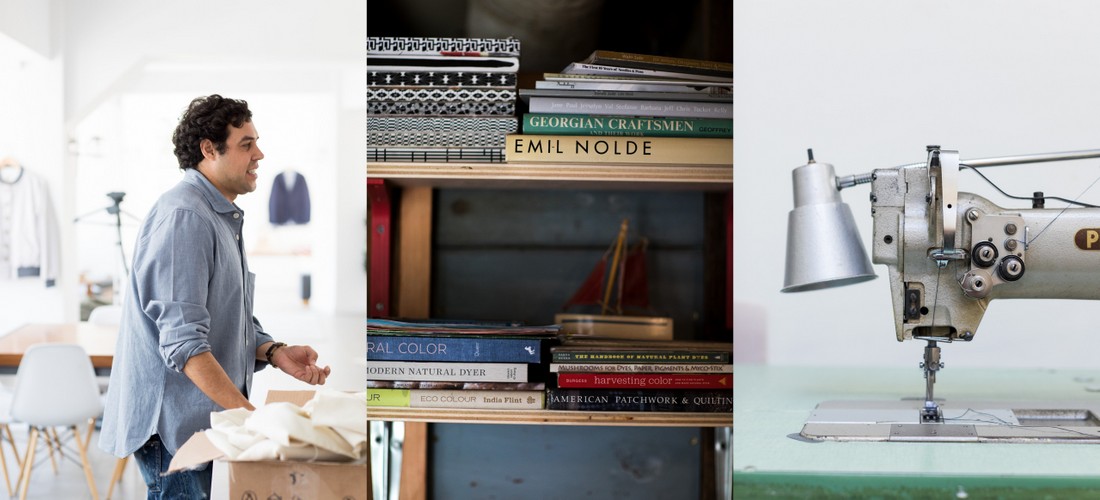
Visiting with Victor Kali (left); a peek into from Matt Katsaros’ library (center); an industrial sewing machine for the hard-wearing constructions of GDS Cloth Goods (right).
On Mentors & Motivators:
Kali Made: “What drives me is building up this industry in this area. Using fabric that has not been made on the west coast for many years. Creating an alternative to that seasonal fashion world that I worked in for so long. It’s exciting to show people that there is another way, that fashion can exist outside the trend paradigm. And it’s really fun, building all these relationships. There’s a cutting factory right down in Fruitvale, and a sewing factory right around on the other side of the lake. So, I can walk over and pop my head in.”
GDS Cloth Goods: “In art school I was really inspired by the work of Andrea Zittel and the Shakers. For them, creating/designing is a way of life. There’s an immense amount of time, energy and respect given to objects that perfectly fit the needs of their lives. I think that this artist and this group have allowed me to accept this part of myself that is present in my work, which is ultimately that I am trying to live a more embodied life, sometimes with the help of meaningful objects… The piece I’m working on now is better communication about why these products are so good. There’s a much larger story to be shared there, and that’s exciting.”
Flint Outdoors: “In one afternoon many years ago, Deepa [Natarajan] introduced me to natural dyes and sent me down a path that has taken me so many places, literally changed the course of my life, educated me on things I never knew I needed an education on, and introduced me to a community of people I am so thankful to have met. I am forever grateful to Deepa and our friendship…. I like to work with friends a lot, I get a lot of inspiration from working with others. You can tie back how I got involved with Fibershed to that desire to help friends and community. My friend sent out an email request to help harvest indigo and I signed up.”
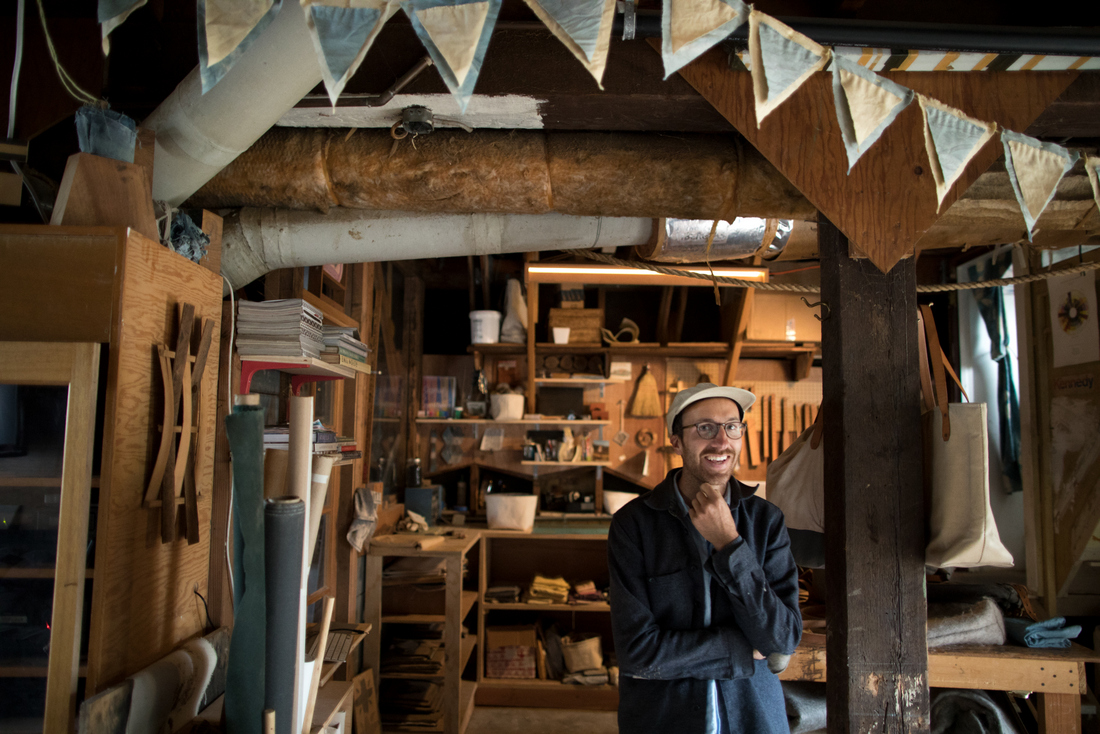
Matt Katsaros shares advice and steps toward sustainable fashion in his studio.
Try this on for size: What first steps can consumers take toward sustainable fashion?
Kali Made: “Focus on one core wardrobe piece that you will want to wear for at least twenty years. Start there.”
GDS Cloth Goods: “It takes having a conversation with yourself because our desire to purchase new things, whether they are sustainable or not, comes from a really personal place and unless we address that, it’s hard to make better decisions about our purchasing patterns. Learning to ask: Why do I need that new thing? What is actually going to be satiated by giving in to this impulse to buy something? What happened the last time I gave in to it? How many times did I wear that thing? and Where is it now? When and if you do decide to purchase something new, focus on items that are made to last for many years and have a timeless aesthetic.”
Flint Outdoors: “Oh every time you just look right here at the material tag. It’s the easiest thing to do, I tell all my friends. Just to raise your awareness of what you are actually buying, which eventually leads you to asking questions.”
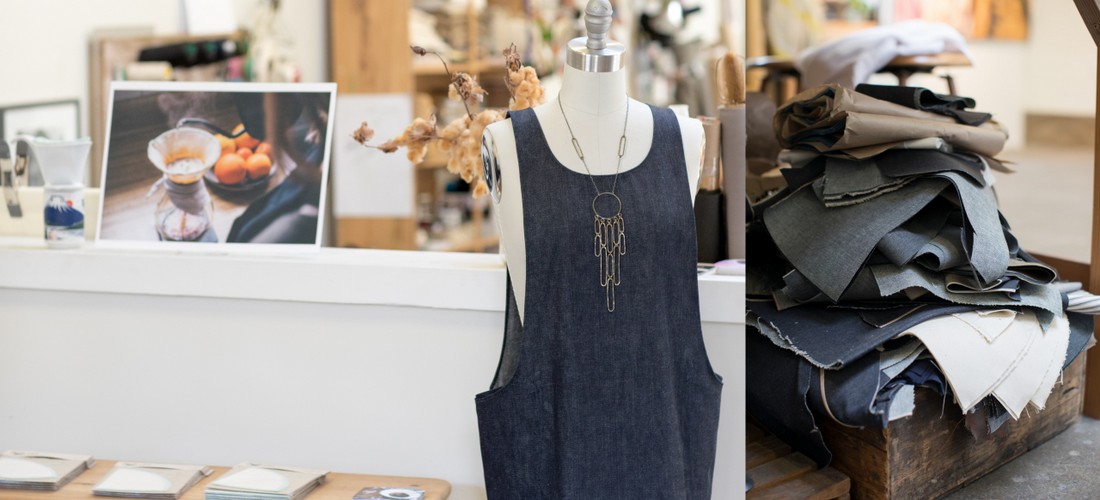
Vignettes around the GDS Cloth Goods studio, showcasing a signature smock, the Ebb coffee filter, educational materials and neatly organized scraps (right).
Try this on for size: What first steps can designers take toward sustainable fashion?
Kali Made: “Do your research. Build that knowledge into your model from the beginning of your line. And focus on the relationships, creating strong ties to the members of this community is both personally very rewarding and beneficial to your bottom line.”
GDS Cloth Goods: “Do it at your own pace, but do it. Start somewhere. Build relationships. Set goals; my personal goal within the next two years is to use only organic cotton or hemp. Use the limitations of what’s available as creative drivers.”
Flint Outdoors: “Stay curious and ask questions, then create a dialogue. I try to learn about things and practice them myself. I don’t put a lot of stock in trying to get other people to do things.”

Gut Reactions: What is your initial response to the Climate Beneficial Wool Community Supported Cloth?
Kali Made: “I love the fabric – it’s dope, and from a design perspective I am stoked to do something cool with it and I want to support Ryan [Huston]’s work. Also, I’m from Norcal and I love the idea that this is made from sheep from Norcal.”
GDS Cloth Goods: “It begs to be several things, the drape of it so good. The thing that I immediately envisioned were really drapey pants, jumpers, or onesie overalls… What I’m most excited about is how it gives designers like myself, people who have prioritized sustainability in their sourcing, more options. It is opening up new possibilities for me. I’ve created this business around what I have access to, so seeing this beautiful wool fabric that is produced in a way that meets or even exceeds my standards for sustainability is exciting.”
Flint Outdoors: “To me the cloth has that really good farm smell. That was one of my favorite parts.”
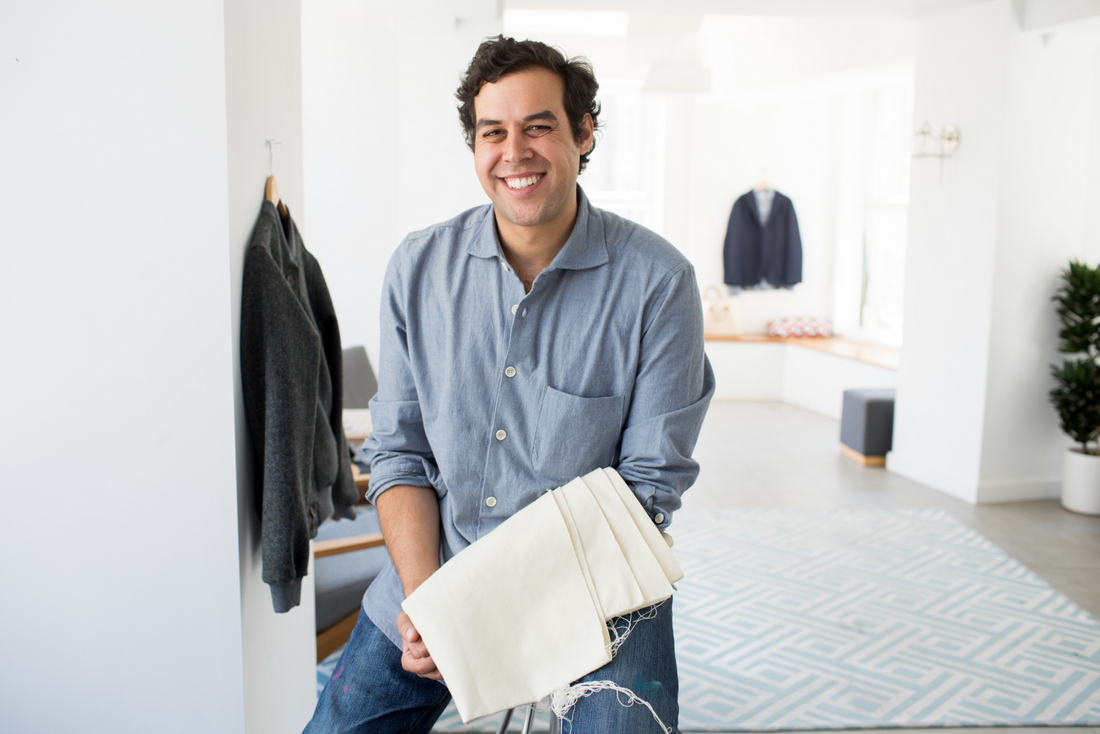
On September 23rd, Climate Beneficial Fashion created by Kali Made, GDS Cloth Goods, and Flint Outdoors, will be presented on the runway at Big Mesa Farm. Reserve a ticket or table to connect with the Fibershed community as we explore value chains that ameliorate the causes of climate change, by investing in carbon farming and regional manufacturing. The evening includes farm-to-table fare, locally crafted beverages, live demonstrations to learn about natural dyeing and fiber processing, and a Marketplace to directly support regional goods and producers.





